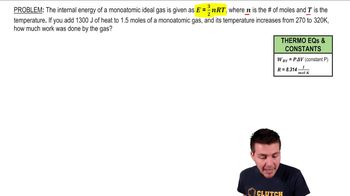Here are the essential concepts you must grasp in order to answer the question correctly.
Ideal Gas Law
The Ideal Gas Law relates the pressure, volume, and temperature of an ideal gas through the equation PV=nRT. In this context, understanding how pressure (p) and volume (V) interact is crucial for analyzing the work done during a gas process. The law assumes that gas particles do not interact and occupy no volume, simplifying calculations in thermodynamic processes.
Recommended video:
Ideal Gases and the Ideal Gas Law
Work Done by a Gas
In thermodynamics, the work done on or by a gas during a volume change is calculated using the integral of pressure with respect to volume. For a process where pressure is a function of volume, the work done can be expressed as W = ∫(p dV). This integral captures the area under the pressure-volume curve, providing insight into energy transfer during the gas expansion or compression.
Recommended video:
Calculating Work Done on Monoatomic Gas
Integration in Physics
Integration is a fundamental mathematical tool used in physics to calculate quantities that accumulate over a continuous range, such as work done or area under a curve. In the context of the given problem, integrating the pressure function p = cV^2/2 with respect to volume allows us to derive the total work done as the gas transitions from an initial volume V₁ to a final volume V₂, highlighting the relationship between pressure and volume changes.
Recommended video:
Finding Moment Of Inertia By Integrating
 Knight Calc 5th Edition
Knight Calc 5th Edition Ch 19: Work, Heat, and the First Law of Thermodynamics
Ch 19: Work, Heat, and the First Law of Thermodynamics Problem 19
Problem 19


